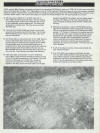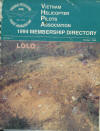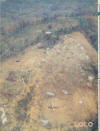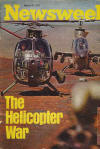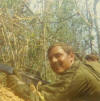![]()
Lam Son 719 - On March 6, 1971 U.S. Airmobile assets launched the largest air assault of the Vietnam war. 120 Huey's lifted two ARVN infantry battalions into the town of Tchepone, Laos.
![]()
|
Lam Son 719 was a major operation of the Army of the Republic of South Vietnam, ARVN, into Laos from 30 Jan - 24 Mar 1971. U.S. provided all of the aviation assets for this operation. A/101 AHB "Comancheros" were one of the aviation units in this operation, along with being the sole 101st Airborne aviation unit supporting the Special Operations Group in I Corp during the month of February 1971.
The objective of Lam Son 719 was to disrupt an ongoing North Vietnamese Army supply buildup at Tchepone, Laos. American Helicopter Units supported and provided all transportation of ARVN troops/supplies into and out of Laos during this operation. The US Helicopter Crewman went against the heaviest anti-aircraft barrage incurred in the War.
The US helicopters that supported Lam Son 719 received fire from rocket propelled grenades, enemy tanks, mortars and small arms fire. The US helicopters were regularly opposed by NVA 23mm, 37mm, and 57mm anti-aircraft weapons along with .51 caliber machine guns arranged to provide mutually supporting anti-aircraft fire. The enemy opposition comprised a permanent logistical force of engineers, transportation, and anti-aircraft troops, together with elements of five divisions that included 12 North Vietnamese infantry regiments, a NVA tank regiment, an NVA artillery regiment, and 19 NVA anti-aircraft battalions.
The South Vietnamese government claimed that 13,341 NVA had been killed against 5,000 ARVN KIA/WIA. American estimates put the ARVN losses at 10,000 which amounted to half of ARVN forces committed to the operation.
The losses to US Helicopter Forces were 65 Helicopter Crewmen KIA, 818 WIA, and 42 MIA. 618 US Helicopters were damaged, including 106 totally destroyed, from 30 Jan - 24 Mar 1971.
The VHPA listing of all of the helicopter units involved in Lam Son 719
A Map of Northern I Corp and Laos with PZ's and LZ's designated.
"The operation was conceived in doubt and assailed by skepticism, preceded in confusion." Dr. Henry Kissinger speaking on Operation Lam Son 719
Scans are from the VHPA 1994 directory© above are property of VHPA they show the location of several downed aircraft on LZ Lolo
Remembrances of LZ Lolo © By Gilbert Alvarado, CE, UH-1H 6816252 LZ LOLO, Lam Son 719 - 03 Mar 1971 LZ LOLO #2
Lieutenant Colonel Mike Sloniker (Ret) writes for this web page:
From
everything I have read about Lam Son 719 since July 1971, the massive buildup
by the NVA using the 559th Logistics Group that was Headquartered near
the Mu Gia Pass was totally not anticipated.
From 08 Feb to 20 Feb, the
ARVN attack was really moving along nicely when the four firebases north of
Hiway 9 started getting overrun. This
was Firebase 30, 31, Ranger North and
Ranger South.
I am of
the basic opinion that NO ONE WAS IN CHARGE during LAM SON 719 because the commands were not unified. Wysong and
Turner were with the 48th at Dong
Ha in a new avn bn numbered the 223d and in the chaos of trying to get
organized and fight an incredible fight in Laos. Then you had the 14th CAB
from Chu Lai, hanging in there pretty good but greatly limited by the
performance of the Charlie Models. Then
there is the 101st that had MANY units flying into Laos before LS 719 for
CCN-4/77th, 101 Avn Bn and the 158th
Avn Bn. So who do we put in as the lead company into LOLO on 03 Mar 71? The Comancheros of A/101 who have done CCN
insertions into LOLO before LS
719? Hell no! The leadership put in the 71st AHC who absolutely got their asses
shot off.
The
whole thing was chaos. The ONLY reason there was ONLY 106 aircraft lost and 65
crewmen killed from 08 Feb 71 to 20 Mar 71 was because of the determination of
the teenagers flying the aircraft who decided THEY were not going to let their
friends down. Had NOTHING to do with
getting the mission done. Had
everything to do with NOT letting your buddy down.
Lieutenant Colonel Mike Sloniker (Ret)
Lt. Colonel Sloniker has collected volumes of
records, interviews, audiotapes, photographs and other information on Lam Son
719. Lt. Col. Sloniker has co-authored and/or assisted on the following books:
Charles Holley/Mike Sloniker, Primer of the
Helicopter War Special thanks are given to Mike for his efforts to record history correctly, from A/101 AVN and all aviation veterans.
|
![]()
![]()
Comanchero Photos from LZ Lolo - March 03, 1971
![]()
|
The following is a reprint from Vietnam
Studies, AIRMOBILITY, 1961-1971, by Lieutenant General John J. Tolson
-Department of the Army, Washington, DC 1973- pages 240-244
Lam Son 719
- The Battle
The attack into Laos was initiated on 8 February
from bases established on the Khe Sanh Plain. The Army of the Republic of
Vietnam 1st Armored Brigade Task Force crossed the border at 1000 and advanced
nine kilometers to the west along Route Nine on the first day. Three battalions
of the 3d Regiment, 1st Army of the Republic of Vietnam Infantry Division, air
assaulted into landing zones south of Route Nine while two battalions of the
1st Army of the Republic of Vietnam Airborne Division air assaulted north of
Route Nine. Some 105-mm howitzer batteries were air-landed in both areas on
D-day.
On 9 February, all air moves were canceled due to
adverse weather; however, the armored task force was able to move two
kilometers further to the west. On 10 February, the 1st Army of the Republic of
Vietnam Airborne Division air assaulted a battalion into Objective Aloui and
the armored task force linked up with this battalion at 1555. On the same day,
the 1st Army of the Republic of Vietnam Division landed a battalion at landing
zone DELTA and the initial objectives of LAM SON 719 had been seized.
After the attack on 8 February the enemy reacted
violently to the allied offensive. He aggressively employed his weapons and
troops already present in Southern Laos and he reinforced heavily his forces
and committed a variety of weapons including tanks to the battle.
Reinforcements came from North Vietnam, South Vietnam, and other parts of Laos.
By 19 February the Rangers in the north were
receiving frequent attacks by medium artillery, sappers, and infantry and
resistance was stiffening in the area of the 1st Army of the Republic of
Vietnam Airborne Division. Resupply and medical evacuation became increasingly
more difficult. When weather precluded the employment of tactical air, as it
often did until noon, and emergency Resupply and medical evacuation was
urgently required, the availability of helicopter gunships became even more
critical.
By 22 February attacks against FireBases 30 and 31
and the Ranger positions were becoming more frequent and more intense. Enemy
mines, ambushes, and the severe lack of maneuver room combined to slow the
movement of the armor columns and they were unable to reach the Rangers to
relieve the pressure. Consequently, it was decided to extract the Rangers on 25
February to a less hostile area near the Republic of Vietnam border. However,
by this time, enemy supply bases one and two kilometers square had been found
and major petroleum, oils, and lubricants pipeline had been found and cut by
Air Cavalry gunships. Tons of ammunition and food stocks had been destroyed.
Six hundred and eighty weapons had been captured.
On 25 February the enemy made a classic armor
attack against FireBase 31. They had moved their armor stealthily over
concealed routes to final assault positions before being discovered. Then the
tanks with supporting infantry launched a violent daylight attack against the
firebase. The defenders, supported by U. S. tactical air, threw back the first
and second waves of the enemy attack; but, on the third wave, three Soviet-made
T-34 tanks made it to the top of the Base and forced the withdrawal of the
defenders. This was to be the first and last success of enemy tanks during
LAM SON
719
and the only friendly firebase to be completely overrun in Laos.
Three Army of the Republic of Vietnam armored
cavalry squadrons and four infantry battalions had not proved sufficient to
provide ground security for the 20 kilometers of road in Laos. Consequently,
General Lam had reassessed his plan of attack after the disappointing results
of friendly armor in keeping open High-way Nine. Obviously he could no longer
plan to use this as a secure main supply route. Capitalizing on his airmobile
support, he decided to attack the main objective of Tchepone with a series of
rapid air assaults along the high escarpment to the south of the river using
the 1st Infantry Division.
From 3 to 6 March the 1st Army of the Republic of
Vietnam Division had accomplished a series of airmobile assaults to the west
along the escarpment-overlooking Route Nine. The first Army of the Republic of
Vietnam units' air assaulted successfully into landing zones
LOLO,
Liz,
and FireBase SOPHIA WEST.
After a very effective preparation of the area by B-52's,
on 6 March two infantry battalions were lifted by 120 Hueys for 65 kilometers
to air assault into landing zone
HOPE
north of Tchepone. This
large combat assault was carried out in what was considered to be the most
hostile air defense environment ever encountered in the entire war, yet only
one Huey was hit and it made a safe landing in the objective area. The
Army of the Republic of Vietnam units attacked south and west controlling the
town. Tchepone was the objective of the allied drive to the west and was the
natural communications hub of the enemy's logistics system in Laos. The enemy
immediately increased his pressure in the Tchepone area and attacked the Army
of the Republic of Vietnam firebases on the escarpment viciously.
The I Corps Commander decided that most of the
objectives of LAM SON 719 had been accomplished and ordered a timed withdrawal
from Laos before weather worsened. During the extraction to the east from the
Tchepone area, new enemy forces brought heavy pressure to bear on the Army of
the Republic of Vietnam all along Route Nine. Extremely heavy antiaircraft
fires were encountered along routes to or from the Army of the Republic of
Vietnam firebases. Enemy pressure was also felt at the primary U. S. Forward
Support Area at Khe Sanh, which received heavy attacks by fire and sappers. All
and all, the enemy used every means at his disposal to make the allied
withdrawal as difficult as possible.
The last elements of the 1st Infantry Division
were extracted on 21 March and the remaining Vietnamese forces withdrew back
into South Vietnam over the next few days. The major airmobile actions in Laos
were terminated by 25 March even though some Army of the Republic of Vietnam
forces continued to operate across the border. Two highly successful airmobile
raids of battalion size were conducted between 31 March and 6 April.
Thousands of tons of ammunition, petroleum, oils,
and lubricants, and other supplies and equipment were destroyed by
LAM SON
719
forces including U. S. air assets. In addition to the destruction of these
stockpiles, supplies from the caches of Base area 604 were at least partially
consumed by the North Vietnam Army forces opposing
LAM SON
719.
Initial reports of supplies and equipment destroyed or captured include over
4,000 individual weapons; more than 1,500 crew-served weapons; 20,000 tons of
ammunition; 12,000 tons of rice; 106 tanks; 76 artillery pieces; and 405
trucks. Over 9,700 secondary explosions further indicate the effectiveness of
B-52 strikes, tactical air, helicopter gunships, and artillery.
As a minimum, it can accurately be stated that the
enemy lines of communication in Base Area 604 were severed, and that supplies
and equipment ceased to move south through this area during the inclusive dates
of the operation. This was particularly significant, for in past years the
enemy has reached his peak efficiency in moving resources south during the
months of February and March. Additionally, the detailed knowledge obtained
concerning the location of depots, trail networks, truck parks, and the fuel
pipeline would permit more precise targeting in the future. Enemy personnel losses were very heavy. While these losses might eventually be replaced, the requirement to replace losses in such regiments as the 1st Viet Cong, 29th, 36th, 64th, 102d, and 803d would, in all probability, draw off replacement personnel programmed for other units. Combined air-ground operations in Base Area 604 resulted in a reported total of 13,914 enemy killed in action. Air and ground attacks inside the five depot areas reportedly accounted for 5,357 of these casualties. An additional 69 enemy soldiers were captured.
|
![]()
![]()
![]()
|
This
is a reprint on Lam Son 719 from the book: 'VIETNAM THE
HELICOPTER WAR' by Philip D. Chinnery 1991, Chapter 11 1971-1972: THE ROAD
HOME, page 157
The battle plan for Lam
Son 719 involved an attack by the Airborne Division and the 1st Armored Brigade
along Highway 9 to Aloui and then on to Tehepone, where Highway 9 intersected
the Ho Chi Minh Trail. Twenty-two miles inside Laos, Tehepone was a major enemy
communications and supply hub. The highway was to be kept open as the main
supply route. The 1st Infantry Division was to attack on a parallel axis to the
main attack along the high ground south of the Xe Pon River and protect the
southern flank of the Airborne Division. The Ranger Group would establish
firebases north of the highway and protect the right flank. A Marine brigade
would remain in reserve near Khe Sanh.
The operation began as
planned with the 1st Armored Brigade Task Force advancing nine kilometers along
Highway 9 on the first day and with three battalions of the 1st Infantry
Division air-assaulting south of the highway and two battalions of the Airborne
Division assaulting to the north. The enemy reacted aggressively, rushing
reinforcements to the area, including tanks. The US Army Cobras tried to halt
the enemy armor and had some success sweeping the accompanying infantry from
the tanks using 2.75-inch Flechette rockets, but the usual high explosive
rockets had only limited success in stopping the tanks. Even when high
explosive, anti-tank rockets were available. The results were mixed. In order
to score a direct hit. The rocket had to be fired from a distance of 500-1,000
meters, which brought the Cobras into the range of the tanks' machine guns and
the enemy infantry in the area. Between 8 February and 24 March the 2nd
Squadron, 17th Cavalry sighted 66 tanks, mostly lightly-armored PT-76s, but
only destroyed six and immobilized eight others. A dedicated tank-busting
helicopter was sorely needed. Soon enemy pressure bogged down the ARVN advance
and poor weather and heavy air defense opposition began to limit the air
support available to relieve the pressure.
By 25 February. The
invading forces had discovered enemy supply bases one and two kilometers square
and had cut a major POL pipeline. However, the tide was beginning to turn and
enemy infantry, supported by tanks, overran FireBase 31, capturing 120 South Vietnamese,
including the battalion commander. With three enemy divisions pressuring them,
the Rangers began to withdraw from their firebases. Unable to continue the
advance along Highway 9, General Lam decided to use his airmobile assets to
launch an air assault on Tchepone and on 6 March 120 Hueys lifted two ARVN
infantry battalions into the town, capturing it against light enemy resistance.
With overall enemy
pressure increasing and the weather worsening, the problem now was how to
withdraw while still in contact with the enemy. It proved impossible to keep
the highway open and secure, so many of the ARVN units were withdrawn by
helicopter and often under fire. Panic occasionally set in and some helicopter
crews resorted to greasing the skids of their Hueys to prevent ARVN troops
clinging to them during the evacuation process. The last elements of the 1st
Infantry Division were extracted on 21 March and the rest of the invasion force
a few days later.
Although thousands of
tons of ammunition, supplies and POL had been destroyed by the ARVN units and
US TACAIR and B-52 strikes. The invading force had been driven out by the North
Vietnamese with heavy losses. The South Vietnamese government claimed that just
under 14,000 enemy had been killed against 6,000 ARVN killed and wounded.
American figures however. Estimated ARVN losses at around 50 percent. With
nearly 10,000 killed. Wounded or missing. United States aircrew losses were 176
killed, 1,942 wounded and 42 missing. Helicopter losses were put at 107
destroyed and 600 damaged.
|
![]()
|
ABC NEWS COMMENTARY By Harry Reasoner 16 February 1971
You can't help but have the feeling that
there will come a future generation of men, if there are any future generations
of men, who will look at old pictures of helicopters and say, "You've got
to be kidding."
All of this, of course, is greatly
complicated by being shot at. American
helicopter pilots are being shot at more often and more accurately these days
from Khe Sahn to Tchepone than at almost any other time in this whole War.
The pilots are beginning to feel like
Mark Twain's man who was tarred and feathered.
|
![]()
If you are interested in reading more on Lam Son 719, I recommend the following sources
- Vietnam Helicopter History CD-ROM This is a outstanding CD with information on Vietnam Helicopters, Helicopter Crews and the missions that they took part in. Available from VHPA
- 506th Infantry "Currahee" 101st Airborne Division Official Documents Lam Son 719 After Action Reports -18 pages
Recommended reading on Lam Son 719, all of these books are available on Amazon and other bookstores.
- “Into Laos” Keith Nolan author.
- "Price of Exit" Tom Marshall author, Pilot C/158th AHB, 101st Airborne
- "Undaunted Valor" Matt Jackson author.
- "Lost Over Laos" Richard Pyle and Horst Faas authors
- "Invasion of Laos 1971" Robert D. Sander author
All of these websites also have information on Lam Son 719 - phase I & II
-
More photos LS 719 http://comanchero.org/pictures27.htm
![]()
![]()
|
Thank you for
your visit to our web site, you are Visitor #
The
photos and written material on this web site may not be published or used
for any
other
use, other than viewing on this site,
without written permission from the Webmaster and the contributor.
All photos and written material remain the personal property
of this web site and it’s contributors. Web-master: Richard A. Bittle
Comanchero Door-Gunner 12/70 - 10/71 DISCLAIMER: Items used on This Web Page are drawn from sources all over the internet, including FTP sites. Some images have been scanned from books and magazines. If information is known about the originator a credit is placed near that item, otherwise if you are the author or photographer and do not want it shown on this web site, please advise the webmaster and it will be removed. None of these items are being sold. No copyright infringement is intended. |
